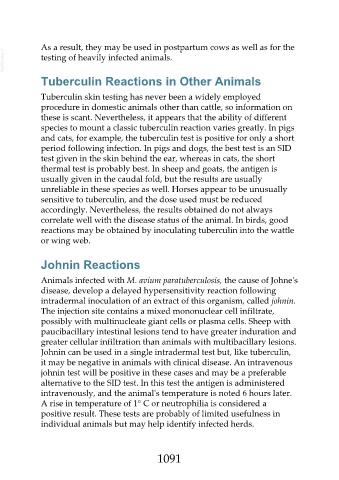Page 1091 - Veterinary Immunology, 10th Edition
P. 1091
As a result, they may be used in postpartum cows as well as for the
VetBooks.ir testing of heavily infected animals.
Tuberculin Reactions in Other Animals
Tuberculin skin testing has never been a widely employed
procedure in domestic animals other than cattle, so information on
these is scant. Nevertheless, it appears that the ability of different
species to mount a classic tuberculin reaction varies greatly. In pigs
and cats, for example, the tuberculin test is positive for only a short
period following infection. In pigs and dogs, the best test is an SID
test given in the skin behind the ear, whereas in cats, the short
thermal test is probably best. In sheep and goats, the antigen is
usually given in the caudal fold, but the results are usually
unreliable in these species as well. Horses appear to be unusually
sensitive to tuberculin, and the dose used must be reduced
accordingly. Nevertheless, the results obtained do not always
correlate well with the disease status of the animal. In birds, good
reactions may be obtained by inoculating tuberculin into the wattle
or wing web.
Johnin Reactions
Animals infected with M. avium paratuberculosis, the cause of Johne's
disease, develop a delayed hypersensitivity reaction following
intradermal inoculation of an extract of this organism, called johnin.
The injection site contains a mixed mononuclear cell infiltrate,
possibly with multinucleate giant cells or plasma cells. Sheep with
paucibacillary intestinal lesions tend to have greater induration and
greater cellular infiltration than animals with multibacillary lesions.
Johnin can be used in a single intradermal test but, like tuberculin,
it may be negative in animals with clinical disease. An intravenous
johnin test will be positive in these cases and may be a preferable
alternative to the SID test. In this test the antigen is administered
intravenously, and the animal's temperature is noted 6 hours later.
A rise in temperature of 1° C or neutrophilia is considered a
positive result. These tests are probably of limited usefulness in
individual animals but may help identify infected herds.
1091

